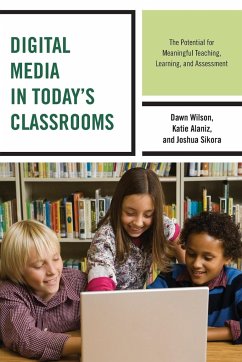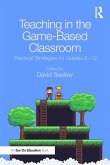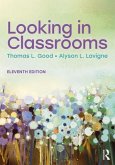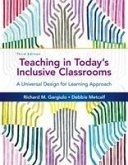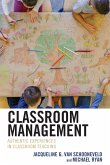Dawn Wilson, Katie Alaniz, Joshua Sikora
Digital Media in Today's Classrooms
The Potential for Meaningful Teaching, Learning, and Assessment
Dawn Wilson, Katie Alaniz, Joshua Sikora
Digital Media in Today's Classrooms
The Potential for Meaningful Teaching, Learning, and Assessment
- Broschiertes Buch
- Merkliste
- Auf die Merkliste
- Bewerten Bewerten
- Teilen
- Produkt teilen
- Produkterinnerung
- Produkterinnerung
The purpose of this book is to help guide teachers and students in benefiting from the vast potential of educationally-driven digital media as a tool for meaningful teaching, learning, and assessment.
Andere Kunden interessierten sich auch für
![Teaching in the Game-Based Classroom Teaching in the Game-Based Classroom]() Teaching in the Game-Based Classroom29,99 €
Teaching in the Game-Based Classroom29,99 €![Looking in Classrooms Looking in Classrooms]() Thomas L. GoodLooking in Classrooms321,99 €
Thomas L. GoodLooking in Classrooms321,99 €![High-Functioning Classrooms High-Functioning Classrooms]() Mark A. MarcheseHigh-Functioning Classrooms22,99 €
Mark A. MarcheseHigh-Functioning Classrooms22,99 €![Looking in Classrooms Looking in Classrooms]() Thomas L. GoodLooking in Classrooms145,99 €
Thomas L. GoodLooking in Classrooms145,99 €![Teaching in Today's Inclusive Classrooms Teaching in Today's Inclusive Classrooms]() Richard Gargiulo (Birmingham University of Alabama)Teaching in Today's Inclusive Classrooms100,99 €
Richard Gargiulo (Birmingham University of Alabama)Teaching in Today's Inclusive Classrooms100,99 €![Classroom Management Classroom Management]() Jacqueline G. Van SchooneveldClassroom Management29,99 €
Jacqueline G. Van SchooneveldClassroom Management29,99 €![Multimedia Learning Multimedia Learning]() Richard E. Mayer (Santa Barbara University of California)Multimedia Learning49,99 €
Richard E. Mayer (Santa Barbara University of California)Multimedia Learning49,99 €-
-
-
The purpose of this book is to help guide teachers and students in benefiting from the vast potential of educationally-driven digital media as a tool for meaningful teaching, learning, and assessment.
Produktdetails
- Produktdetails
- Verlag: Bloomsbury Publishing Plc
- Seitenzahl: 176
- Erscheinungstermin: 8. Dezember 2016
- Englisch
- Abmessung: 229mm x 152mm x 10mm
- Gewicht: 276g
- ISBN-13: 9781475821062
- ISBN-10: 1475821069
- Artikelnr.: 45374581
- Herstellerkennzeichnung
- Libri GmbH
- Europaallee 1
- 36244 Bad Hersfeld
- gpsr@libri.de
- Verlag: Bloomsbury Publishing Plc
- Seitenzahl: 176
- Erscheinungstermin: 8. Dezember 2016
- Englisch
- Abmessung: 229mm x 152mm x 10mm
- Gewicht: 276g
- ISBN-13: 9781475821062
- ISBN-10: 1475821069
- Artikelnr.: 45374581
- Herstellerkennzeichnung
- Libri GmbH
- Europaallee 1
- 36244 Bad Hersfeld
- gpsr@libri.de
Dawn Wilson, Katie Alaniz, Joshua Sikora
Acknowledgements
Introduction
Chapter 1: Digital Media - What Is It, and Why Does It Matter?
Who Are These 21st Century Learners?What Is Digital Media and How Does It
Impact Learning?Digital Media: The Ever-Present Companion of Today's
StudentsHow Can Teachers Enhance Students' 21st Century Literacy Skills?How
Do Educational Standards and Media Correlate?Essential Ideas to
RememberReferencesChapter 2: Research Findings and the Implications on
Learning
How Does Technology Impact Learning?How Does Multimedia Content Impact
Learning?How Is the Role of Video Content in Student Leaning
Evolving?Research ImplicationsEssential Ideas to RememberReferencesChapter
3: Essential Considerations in Using Digital Media
The Growing Imperative of Media LiteracySuffering Not from Lack of
Innovation, but Rather Lack of EducationIn the Digital World, as in the
Physical World, Student Safety is ParamountCoping with COPPANow Playing in
a Classroom Near You.Giving Credit Where Credit Is DueThe Code of Best
Practices in Fair Use for Media Literacy EducationEssential Ideas to
RememberReferencesChapter 4:Planning for Digital Media: Settings,
Groupings, and Platforms
First Things FirstThe Understanding by Design FrameworkThe Universal Design
for Learning (UDL) ModelBloom's TaxonomyClassroom Instruction That
WorksDigital Media's Role Within These FrameworksSharpening the Axe:
Crucial Factors to Consider When Planning for Digital Media
IntegrationReady, Set, Learn!Where to Begin?Essential Ideas to
RememberReferencesChapter 5: Using Digital Media to READY Students for
Learning: Preparing Learners to Acquire Key Knowledge and Skills
Readying Instructional ResourcesReadying the Learners: Activating
Engagement, Motivation, and InterestWhat's the Point?The Power of Prior
KnowledgeThe Potential of a Focused MindThe Promise of Personal InterestThe
Potent Influence of Personal Motivation"TEASe"ing the Students to Impact
Attention, Motivation, and InterestEssential Ideas to RememberTEASe Making
ResourcesReferencesChapter 6: SETTING Meaningful Learning: Supporting
Students with Content Acquisition
Why Reinvent the Wheel? The Benefits of Pre-Created Digital MediaLights,
Camera, Action! The Enchanting Features of Film in Classroom
SettingsLearners as Viewers: Leveraging the Transportive Potential of
MediaTapping the Riches of Pre-Created Digital Media ContentLearners as
Participants: Actively Engaging Students with Interactive ResourcesThe Best
of Both Worlds: Digital Media Options that Enable Students to Interact as
Viewers and ParticipantsDigital Media in Action: Examples of Digital Media
Lessons in Classroom SettingsEssential Ideas to RememberChapter 7: LEARNING
with Digital Media: Empowering Students to Demonstrate Learning through
Design and Creation
It's Not Going to Be Easy, But It Will Be Worth It!Positioning Students in
the Driver's SeatPutting the Pedal to the Metal: Encouraging Students to
Lead the Way through AuthoringWhat's the Point? Driving Media Integration
with PurposeDecisions, Decisions: Crucial Considerations for Successfully
Implementing Student-Centered Digital MediaInspiration for the Journey:
Examples of Student-Centered Digital Media ProjectsEssential Ideas to
RememberChapter 8: Assessing the Use of Digital Media
An Assortment of Assessment TypesA Time and a Place for Every Assessment
TypeAssessing with PurposeAesthetic Appeal: Stressing the Significance of
StylePresentation Is Everything... Or at Least Highly Important!Teamwork
Makes the Dream Work: Fostering Classroom CollaborationAssessment in
Action: Representative Rubrics to Guide the JourneyEssential Ideas to
RememberReferencesChapter 9:Digital Media for Flipped or Distance Learning
What Is Virtual Learning, and What's the Big Deal?Blended Learning: The
Best of Both Worlds?Flip It! Flip It Good!The Art of Flipping: Putting It
into PracticeMaking the Most of Increased Class TimeTools for
CreatingEvaluatingAnalyzingApplyingUnderstanding and RememberingTo Create
or Not to Create? That Is the Question!Think Before You Flip: Key
Considerations Prior to FlippingCreating Screencasts with a
ComputerCreating Screencasts with an iPadThe Challenge: Finding the Perfect
Place to Store Resources for Sharing and ViewingInspiration for Future
Flipping EndeavorsEssential Ideas to RememberReferencesChapter 10: Looking
Forward to What is Next: Future Technologies and Their Role in the
Classroom
Silicon Valley's InfluenceSoftware-Supported Personalized LearningVirtual
Reality and Augmented RealityChanging Landscapes and Changing
StudentsEssential Ideas to RememberReferences
Introduction
Chapter 1: Digital Media - What Is It, and Why Does It Matter?
Who Are These 21st Century Learners?What Is Digital Media and How Does It
Impact Learning?Digital Media: The Ever-Present Companion of Today's
StudentsHow Can Teachers Enhance Students' 21st Century Literacy Skills?How
Do Educational Standards and Media Correlate?Essential Ideas to
RememberReferencesChapter 2: Research Findings and the Implications on
Learning
How Does Technology Impact Learning?How Does Multimedia Content Impact
Learning?How Is the Role of Video Content in Student Leaning
Evolving?Research ImplicationsEssential Ideas to RememberReferencesChapter
3: Essential Considerations in Using Digital Media
The Growing Imperative of Media LiteracySuffering Not from Lack of
Innovation, but Rather Lack of EducationIn the Digital World, as in the
Physical World, Student Safety is ParamountCoping with COPPANow Playing in
a Classroom Near You.Giving Credit Where Credit Is DueThe Code of Best
Practices in Fair Use for Media Literacy EducationEssential Ideas to
RememberReferencesChapter 4:Planning for Digital Media: Settings,
Groupings, and Platforms
First Things FirstThe Understanding by Design FrameworkThe Universal Design
for Learning (UDL) ModelBloom's TaxonomyClassroom Instruction That
WorksDigital Media's Role Within These FrameworksSharpening the Axe:
Crucial Factors to Consider When Planning for Digital Media
IntegrationReady, Set, Learn!Where to Begin?Essential Ideas to
RememberReferencesChapter 5: Using Digital Media to READY Students for
Learning: Preparing Learners to Acquire Key Knowledge and Skills
Readying Instructional ResourcesReadying the Learners: Activating
Engagement, Motivation, and InterestWhat's the Point?The Power of Prior
KnowledgeThe Potential of a Focused MindThe Promise of Personal InterestThe
Potent Influence of Personal Motivation"TEASe"ing the Students to Impact
Attention, Motivation, and InterestEssential Ideas to RememberTEASe Making
ResourcesReferencesChapter 6: SETTING Meaningful Learning: Supporting
Students with Content Acquisition
Why Reinvent the Wheel? The Benefits of Pre-Created Digital MediaLights,
Camera, Action! The Enchanting Features of Film in Classroom
SettingsLearners as Viewers: Leveraging the Transportive Potential of
MediaTapping the Riches of Pre-Created Digital Media ContentLearners as
Participants: Actively Engaging Students with Interactive ResourcesThe Best
of Both Worlds: Digital Media Options that Enable Students to Interact as
Viewers and ParticipantsDigital Media in Action: Examples of Digital Media
Lessons in Classroom SettingsEssential Ideas to RememberChapter 7: LEARNING
with Digital Media: Empowering Students to Demonstrate Learning through
Design and Creation
It's Not Going to Be Easy, But It Will Be Worth It!Positioning Students in
the Driver's SeatPutting the Pedal to the Metal: Encouraging Students to
Lead the Way through AuthoringWhat's the Point? Driving Media Integration
with PurposeDecisions, Decisions: Crucial Considerations for Successfully
Implementing Student-Centered Digital MediaInspiration for the Journey:
Examples of Student-Centered Digital Media ProjectsEssential Ideas to
RememberChapter 8: Assessing the Use of Digital Media
An Assortment of Assessment TypesA Time and a Place for Every Assessment
TypeAssessing with PurposeAesthetic Appeal: Stressing the Significance of
StylePresentation Is Everything... Or at Least Highly Important!Teamwork
Makes the Dream Work: Fostering Classroom CollaborationAssessment in
Action: Representative Rubrics to Guide the JourneyEssential Ideas to
RememberReferencesChapter 9:Digital Media for Flipped or Distance Learning
What Is Virtual Learning, and What's the Big Deal?Blended Learning: The
Best of Both Worlds?Flip It! Flip It Good!The Art of Flipping: Putting It
into PracticeMaking the Most of Increased Class TimeTools for
CreatingEvaluatingAnalyzingApplyingUnderstanding and RememberingTo Create
or Not to Create? That Is the Question!Think Before You Flip: Key
Considerations Prior to FlippingCreating Screencasts with a
ComputerCreating Screencasts with an iPadThe Challenge: Finding the Perfect
Place to Store Resources for Sharing and ViewingInspiration for Future
Flipping EndeavorsEssential Ideas to RememberReferencesChapter 10: Looking
Forward to What is Next: Future Technologies and Their Role in the
Classroom
Silicon Valley's InfluenceSoftware-Supported Personalized LearningVirtual
Reality and Augmented RealityChanging Landscapes and Changing
StudentsEssential Ideas to RememberReferences
Acknowledgements
Introduction
Chapter 1: Digital Media - What Is It, and Why Does It Matter?
Who Are These 21st Century Learners?What Is Digital Media and How Does It
Impact Learning?Digital Media: The Ever-Present Companion of Today's
StudentsHow Can Teachers Enhance Students' 21st Century Literacy Skills?How
Do Educational Standards and Media Correlate?Essential Ideas to
RememberReferencesChapter 2: Research Findings and the Implications on
Learning
How Does Technology Impact Learning?How Does Multimedia Content Impact
Learning?How Is the Role of Video Content in Student Leaning
Evolving?Research ImplicationsEssential Ideas to RememberReferencesChapter
3: Essential Considerations in Using Digital Media
The Growing Imperative of Media LiteracySuffering Not from Lack of
Innovation, but Rather Lack of EducationIn the Digital World, as in the
Physical World, Student Safety is ParamountCoping with COPPANow Playing in
a Classroom Near You.Giving Credit Where Credit Is DueThe Code of Best
Practices in Fair Use for Media Literacy EducationEssential Ideas to
RememberReferencesChapter 4:Planning for Digital Media: Settings,
Groupings, and Platforms
First Things FirstThe Understanding by Design FrameworkThe Universal Design
for Learning (UDL) ModelBloom's TaxonomyClassroom Instruction That
WorksDigital Media's Role Within These FrameworksSharpening the Axe:
Crucial Factors to Consider When Planning for Digital Media
IntegrationReady, Set, Learn!Where to Begin?Essential Ideas to
RememberReferencesChapter 5: Using Digital Media to READY Students for
Learning: Preparing Learners to Acquire Key Knowledge and Skills
Readying Instructional ResourcesReadying the Learners: Activating
Engagement, Motivation, and InterestWhat's the Point?The Power of Prior
KnowledgeThe Potential of a Focused MindThe Promise of Personal InterestThe
Potent Influence of Personal Motivation"TEASe"ing the Students to Impact
Attention, Motivation, and InterestEssential Ideas to RememberTEASe Making
ResourcesReferencesChapter 6: SETTING Meaningful Learning: Supporting
Students with Content Acquisition
Why Reinvent the Wheel? The Benefits of Pre-Created Digital MediaLights,
Camera, Action! The Enchanting Features of Film in Classroom
SettingsLearners as Viewers: Leveraging the Transportive Potential of
MediaTapping the Riches of Pre-Created Digital Media ContentLearners as
Participants: Actively Engaging Students with Interactive ResourcesThe Best
of Both Worlds: Digital Media Options that Enable Students to Interact as
Viewers and ParticipantsDigital Media in Action: Examples of Digital Media
Lessons in Classroom SettingsEssential Ideas to RememberChapter 7: LEARNING
with Digital Media: Empowering Students to Demonstrate Learning through
Design and Creation
It's Not Going to Be Easy, But It Will Be Worth It!Positioning Students in
the Driver's SeatPutting the Pedal to the Metal: Encouraging Students to
Lead the Way through AuthoringWhat's the Point? Driving Media Integration
with PurposeDecisions, Decisions: Crucial Considerations for Successfully
Implementing Student-Centered Digital MediaInspiration for the Journey:
Examples of Student-Centered Digital Media ProjectsEssential Ideas to
RememberChapter 8: Assessing the Use of Digital Media
An Assortment of Assessment TypesA Time and a Place for Every Assessment
TypeAssessing with PurposeAesthetic Appeal: Stressing the Significance of
StylePresentation Is Everything... Or at Least Highly Important!Teamwork
Makes the Dream Work: Fostering Classroom CollaborationAssessment in
Action: Representative Rubrics to Guide the JourneyEssential Ideas to
RememberReferencesChapter 9:Digital Media for Flipped or Distance Learning
What Is Virtual Learning, and What's the Big Deal?Blended Learning: The
Best of Both Worlds?Flip It! Flip It Good!The Art of Flipping: Putting It
into PracticeMaking the Most of Increased Class TimeTools for
CreatingEvaluatingAnalyzingApplyingUnderstanding and RememberingTo Create
or Not to Create? That Is the Question!Think Before You Flip: Key
Considerations Prior to FlippingCreating Screencasts with a
ComputerCreating Screencasts with an iPadThe Challenge: Finding the Perfect
Place to Store Resources for Sharing and ViewingInspiration for Future
Flipping EndeavorsEssential Ideas to RememberReferencesChapter 10: Looking
Forward to What is Next: Future Technologies and Their Role in the
Classroom
Silicon Valley's InfluenceSoftware-Supported Personalized LearningVirtual
Reality and Augmented RealityChanging Landscapes and Changing
StudentsEssential Ideas to RememberReferences
Introduction
Chapter 1: Digital Media - What Is It, and Why Does It Matter?
Who Are These 21st Century Learners?What Is Digital Media and How Does It
Impact Learning?Digital Media: The Ever-Present Companion of Today's
StudentsHow Can Teachers Enhance Students' 21st Century Literacy Skills?How
Do Educational Standards and Media Correlate?Essential Ideas to
RememberReferencesChapter 2: Research Findings and the Implications on
Learning
How Does Technology Impact Learning?How Does Multimedia Content Impact
Learning?How Is the Role of Video Content in Student Leaning
Evolving?Research ImplicationsEssential Ideas to RememberReferencesChapter
3: Essential Considerations in Using Digital Media
The Growing Imperative of Media LiteracySuffering Not from Lack of
Innovation, but Rather Lack of EducationIn the Digital World, as in the
Physical World, Student Safety is ParamountCoping with COPPANow Playing in
a Classroom Near You.Giving Credit Where Credit Is DueThe Code of Best
Practices in Fair Use for Media Literacy EducationEssential Ideas to
RememberReferencesChapter 4:Planning for Digital Media: Settings,
Groupings, and Platforms
First Things FirstThe Understanding by Design FrameworkThe Universal Design
for Learning (UDL) ModelBloom's TaxonomyClassroom Instruction That
WorksDigital Media's Role Within These FrameworksSharpening the Axe:
Crucial Factors to Consider When Planning for Digital Media
IntegrationReady, Set, Learn!Where to Begin?Essential Ideas to
RememberReferencesChapter 5: Using Digital Media to READY Students for
Learning: Preparing Learners to Acquire Key Knowledge and Skills
Readying Instructional ResourcesReadying the Learners: Activating
Engagement, Motivation, and InterestWhat's the Point?The Power of Prior
KnowledgeThe Potential of a Focused MindThe Promise of Personal InterestThe
Potent Influence of Personal Motivation"TEASe"ing the Students to Impact
Attention, Motivation, and InterestEssential Ideas to RememberTEASe Making
ResourcesReferencesChapter 6: SETTING Meaningful Learning: Supporting
Students with Content Acquisition
Why Reinvent the Wheel? The Benefits of Pre-Created Digital MediaLights,
Camera, Action! The Enchanting Features of Film in Classroom
SettingsLearners as Viewers: Leveraging the Transportive Potential of
MediaTapping the Riches of Pre-Created Digital Media ContentLearners as
Participants: Actively Engaging Students with Interactive ResourcesThe Best
of Both Worlds: Digital Media Options that Enable Students to Interact as
Viewers and ParticipantsDigital Media in Action: Examples of Digital Media
Lessons in Classroom SettingsEssential Ideas to RememberChapter 7: LEARNING
with Digital Media: Empowering Students to Demonstrate Learning through
Design and Creation
It's Not Going to Be Easy, But It Will Be Worth It!Positioning Students in
the Driver's SeatPutting the Pedal to the Metal: Encouraging Students to
Lead the Way through AuthoringWhat's the Point? Driving Media Integration
with PurposeDecisions, Decisions: Crucial Considerations for Successfully
Implementing Student-Centered Digital MediaInspiration for the Journey:
Examples of Student-Centered Digital Media ProjectsEssential Ideas to
RememberChapter 8: Assessing the Use of Digital Media
An Assortment of Assessment TypesA Time and a Place for Every Assessment
TypeAssessing with PurposeAesthetic Appeal: Stressing the Significance of
StylePresentation Is Everything... Or at Least Highly Important!Teamwork
Makes the Dream Work: Fostering Classroom CollaborationAssessment in
Action: Representative Rubrics to Guide the JourneyEssential Ideas to
RememberReferencesChapter 9:Digital Media for Flipped or Distance Learning
What Is Virtual Learning, and What's the Big Deal?Blended Learning: The
Best of Both Worlds?Flip It! Flip It Good!The Art of Flipping: Putting It
into PracticeMaking the Most of Increased Class TimeTools for
CreatingEvaluatingAnalyzingApplyingUnderstanding and RememberingTo Create
or Not to Create? That Is the Question!Think Before You Flip: Key
Considerations Prior to FlippingCreating Screencasts with a
ComputerCreating Screencasts with an iPadThe Challenge: Finding the Perfect
Place to Store Resources for Sharing and ViewingInspiration for Future
Flipping EndeavorsEssential Ideas to RememberReferencesChapter 10: Looking
Forward to What is Next: Future Technologies and Their Role in the
Classroom
Silicon Valley's InfluenceSoftware-Supported Personalized LearningVirtual
Reality and Augmented RealityChanging Landscapes and Changing
StudentsEssential Ideas to RememberReferences

